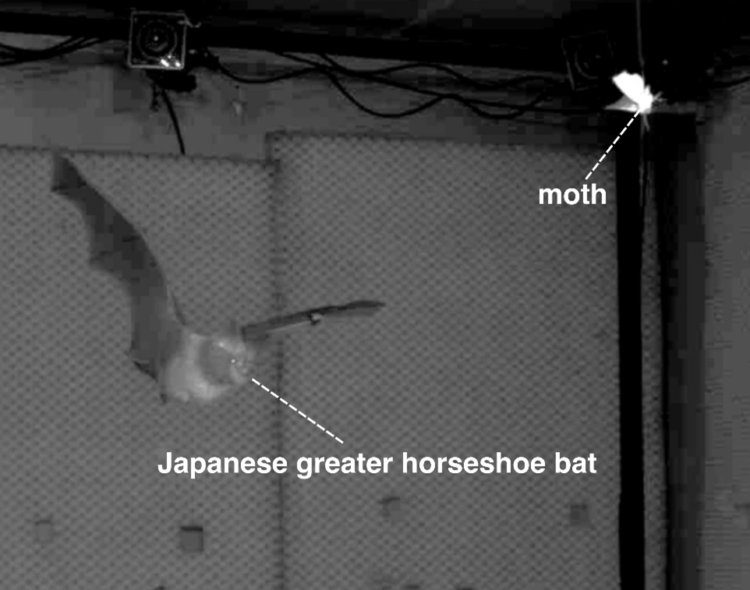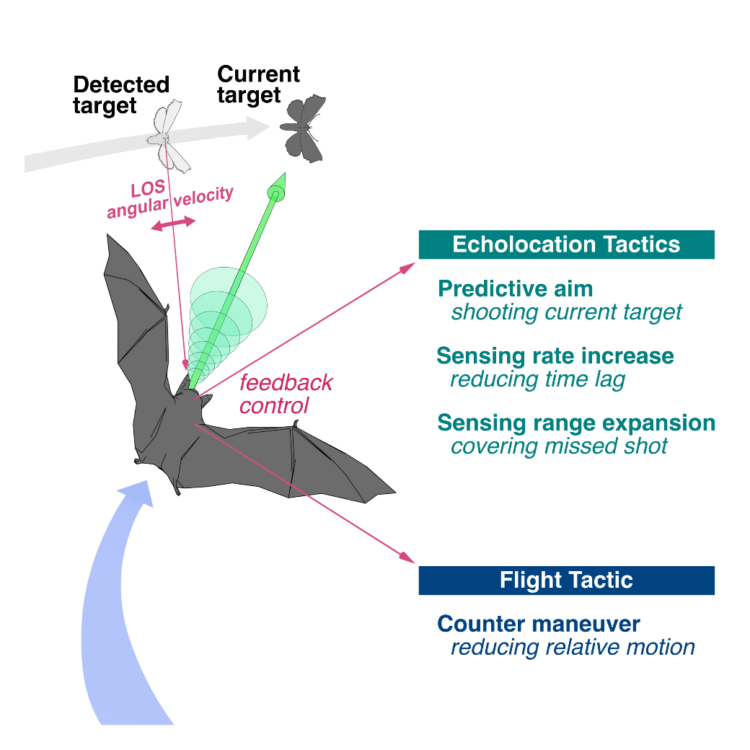Research News: Target tracking strategy in bats: integration of echolocation and flight tactics
June 28, 2024
The ability of “target tracking”, i.e., keeping a target object in sight, is essential for various activities and has improved in animals and machines through the evolution of life and technology, respectively. Because most sensing systems are inevitably subject to a certain degree of delay caused by information processing, many studies have addressed the challenge of overcoming this delay constraint for more accurate target tracking. On this point, studying animals’ sophisticated tracking behavior would bring a significant breakthrough against this fundamental problem.
Taking advantage of free-moving bats chasing moths as a realistic model of target tracking, a team consisting of researchers from the National Institute for Basic Biology of Japan and Doshisha University found that bats used the four key tactics and organized them effectively to track prey accurately. The team also proposed a possible operational rule enabling bats to exercise this strategy efficiently.
“This research was conducted by 3D motion analysis and computer simulations on previously recorded bat-moth interactions, where 3D trajectories and ultrasounds of bats (Rhinolophus nippon) during encounters with prey moths were observed in an experiment chamber, using two high-speed cameras and many microphones on the walls of the chamber,” explains Dr. Nozomi Nishiumi of the National Institute for Basic Biology, corresponding author of the report published in Current Biology.
The research team first demonstrated that bats simultaneously deploy following the four tactical elements.
(Video link: https://youtu.be/sIjwf_rUgzk)
1) Prediction of the target direction
2) Adjustment of the sensing rate
3) Adjustment of the sensing angular range
4) Stabilization of the target direction by counter maneuvers
In addition, the results from computer simulations demonstrated that the combination of the above tactics greatly and robustly improves the tracking accuracy over a wide range of the delay constraint.
The team also showed that control of those tactics can be explained by a concise rule based on the angular velocity of the target direction, which suggests that bats successfully reduce the burden of multitasking management. Summarizing these findings, the team proposed a conceptual framework for orchestrating several tactics for efficient target tracking.
“Although we used active-sensing bats as subjects, the problem of delay in target tracking and the countermeasures against it are common in various active/passive-sensing animals and devices,” explains Dr. Nishiumi.
“It was surprising that echolocating bats track their prey with precision not only by expansion of their biosonar field of view, which was published in 2013, but also by integrating other skillful echolocation and flight tactics,” explains Dr. Fujioka at Doshisha University.
Through the demonstration of the sophisticated strategy used by bats, their findings would provide insights into the understanding and development of a wide range of objects that engage in target tracking.

A Japanese greater horseshoe bat (Rhinolophus nippon) chasing a moth in an experiment chamber
Credit: Doshisha University

Outline of the target tracking tactics in Japanese greater horseshoe bat.
The combination of three echolocation tactics and
one flight tactic works to dramatically improve the tracking accuracy.
All tactics can be explained as reactive control
to the Line of Sight [LOS] angular velocity.
Credit: Nozomi Nishiumi
Reference
| Title of original paper | Bats integrate multiple echolocation and flight tactics to track prey |
| Journal | Current Biology |
| DOI | https://doi.org/10.1016/j.cub.2024.05.062 |
EurekAlert
https://www.eurekalert.org/news-releases/1049330
Profiles

Nozomi Nishiumi
JSPS Research fellow, National Institute for Basic Biology, Japan
Nozomi Nishiumi is a JSPS research fellow at the National Institute for Basic Biology, Japan. His research activities are supported by the Japan Society for the Promotion of Science (JSPS). His research interests include adaptive decision-making and behavioral strategies of animals, especially in adversarial relationships such as those between predators and prey. He has published on these topics in scientific journals, including several papers on strategies in predator snakes and prey frogs, and has also contributed to official textbooks for Japanese high schools. His work has been recognized with awards such as the Japan Ethological Society Award and the Journal of Ethology Editors’ Choice Award.
Researcher profile https://researchmap.jp/Nozomi-Nishiumi

Emyo Fujioka
Associate Professor,
Doshisha University, Japan
Emyo Fujioka is a research fellow / associate professor in Organization for Research Initiatives and Development at Doshisha University. His research interests include bat bioacoustics, especially in sensory and behavioral ecology of echolocating bats. He has published on these topics in scientific journals, including several papers on echolocation strategies of bats during natural foraging. His work has been recognized with awards such as the Marine Acoustics Society Paper Award, Best Presentation Award (GOLD PRIZE) in the 3rd International Symposium on Innovative Mathematical Modelling, Student Presentation Award from Acoustical society of Japan.
Researcher profile https://researchmap.jp/emyo_fujioka

Shizuko Hiryu
Professor,
Faculty of Life and Medical Sciences,
Department of Biomedical Information,
Doshisha University, JAPAN
Shizuko Hiryu is a Professor in the Faculty of Life and Medical Sciences, Department of Biomedical Information at Doshisha University. She joined IBM Japan, Ltd. in 1999 and obtained a Ph.D. in Engineering from Doshisha University in 2006. Her research interests include ultrasonic engineering, bat bioacoustics, and sensing. She has published extensively on these topics in scientific journals, including several papers on echolocation and acoustic simulations in bats. From 2014 to 2018, she served as a JST
PRESTO researcher. She is a member of several academic societies and committees and has received numerous awards for her work on echolocation and bioacoustics in bats, such as the MEXT Young Scientists’ Prize and the JSPS Award.
Researcher profile https://researchmap.jp/Shizuko_Hiryu/?lang=en
Media contact
Organization for Research Initiatives & Development
Doshisha University
Kyotanabe, Kyoto 610-0394, JAPAN
E-mail:jt-ura@mail.doshisha.ac.jp
